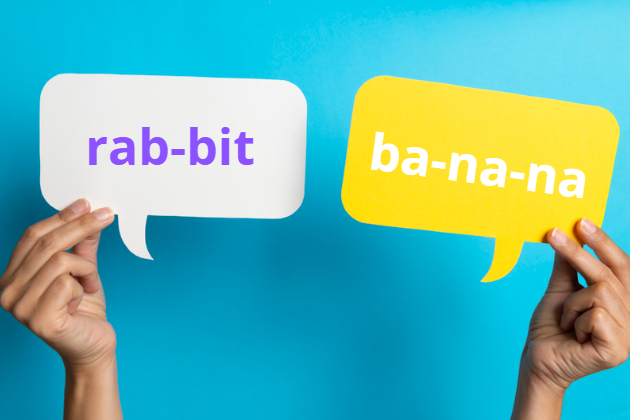What is a syllable?
Examples
- a → a (1 syllable)
- bread → bread (1 syllable)
- female → fe-male(2 syllables)
- bicycle* → bi-cy-cle (3 syllables)
- interesting → in-ter-est-ing (4 syllables)
* Note the consonant “y” is not strictly a vowel but behaves like one.
Seven rules to divide words into syllables
Rule # 1
A syllable is formed by at least one vowel (a, e, i, o, u).
For example: a, the, plant, ba-na-na, chil-dren, cam-er-a.
Exceptions:
a) Silent e is not counted as a vowel in a syllable.
For example: tape, like, love, ex-treme, take, blue.
b) When two vowels carry one sound (diphthong), they cannot be divided.
For example: coin, loud, bread, moon, sound, beau-ti-ful, a-void.
c) The letter “y” is not strictly a vowel but behaves like one.
For example: man-y, bi-cy-cle, i-vy.
Rule # 2
Divide the syllable between two same consonants.
For example: rab-bit, let-ter, buf-fet, des-sert, ber-ry.
Rule # 3
Vowel with long/short vowel sound...
a) The consonant goes with the second vowel if the first vowel has a long vowel sound.
For example: ba-sic, ro-bot, wa-ter.
b) The consonant goes with the first vowel if it has a short vowel sound.
For example: riv-er, mod-el, pan-el.
Exception:
Never split two consonants that make only one sound (ch, sh, ph, th, wh & gh) when pronounced together and aren't the same letter (diagraphs).
For example: teach-er, lash-es, graph-ic, pan-ther, bath-tub.
Rule# 4
Divide between two vowels that make two sounds.
For example: di-et, di-aer-e-sis.
Exception:
Two vowels make one sound.
For example: coat, boat, meet.
Rule # 5
Use prefixes and suffixes to separate syllables.
For example: re-turn, un-u-su-al, pre-paid, end-less, pay-ing, hap-pi-ness, un-kind-ly.
Rule # 6
Compound nouns are always divided between the two words.
For example: some-thing, cup-cake, with-out, how-ev-er, ba-by-sit-ter, class-room, break-fast, sun-flow-er.
Rule # 7
Divide before the consonant before an "-le" syllable and sounds like “-el”.
For example: a-ble, can-dle, fum-ble, ap-ple, ta-ble, cas-tle.
Exception:
Words which end with “ckle”.
For example: tick-le, tack-le.
- basketball
- elepant
- accelerate
- beaver
- reptile
- photographic
- construct
- analytically
- incomprehensibly
- ophthalmology
- bas-ket-ball (3 syllables)
- el-e-phant (3 syllables)
- ac-cel-er-ate (5 syllables)
- bea-ver (2 syllables)
- rep-tile (2 syllables)
- pho-to-graph-ic (4 syllables)
- con-struct (2 syllables)
- an-a-lyt-i-cal-ly (6 syllables)
- in-com-pre-hen-si-bly (6 syllables)
- oph-thal-mol-o-gy (5 syllables)


